
Denys Rayner
Encyclopedia
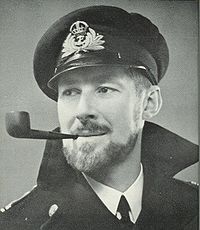
Distinguished Service Cross (United Kingdom)
The Distinguished Service Cross is the third level military decoration awarded to officers, and other ranks, of the British Armed Forces, Royal Fleet Auxiliary and British Merchant Navy and formerly also to officers of other Commonwealth countries.The DSC, which may be awarded posthumously, is...
, VRD
Volunteer Reserve Decoration
The Volunteer Reserve Decoration was awarded to commissioned officers in the United Kingdom's Royal Naval Volunteer Reserve for long service and good conduct.The VRD was established in 1908...
, RNVR (9 February 1908 - 4 January 1967) fought throughout the Battle of the Atlantic. After intensive war service at sea, Rayner became a writer, a farmer, and a successful designer and builder of small sailing craft - his first being the Westcoaster; his most successful being the glass fibre gunter
Gunter
In sailing, a gunter is used for two main configurations of rig:#The gunter is defined as a wire that leads from one point near the end of a gaff to a point near the other end. A block travels along this wire, and a halyard is attached to this block...
or Bermudian rigged twin keel Westerly 22 from which evolved similar "small ships" able to cross oceans while respecting the expectations, in terms of comfort, safety and cost, of a burgeoning family market keen to get to sea. Before his death in 1967, Rayner had founded, and via his pioneering GRP
Glass-reinforced plastic
Fiberglass , is a fiber reinforced polymer made of a plastic matrix reinforced by fine fibers of glass. It is also known as GFK ....
designs, secured the future expansion of Westerly Marine Construction Ltd - up until the late 1980s, one of Britain's most successful yacht builders.
Denys Rayner was born in Muswell Hill in a Georgian house, on the outskirts of London, to Francis (née Parker) and Arthur Rayner, a master electrical engineer, who became a commodity broker
Commodity broker
A commodity broker is a firm or individual who executes orders to buy or sell commodity contracts on behalf of clients and charges them a commission. A firm or individual who trades for his own account is called a trader. Commodity contracts include futures, options, and similar financial...
moving with his family to West Kirby
West Kirby
West Kirby is a town on the north-west corner of the coast of the Wirral Peninsula, England, at the mouth of the River Dee across from the Point of Ayr in North Wales. To the north-east of the town lies Hoylake, with the suburbs of Grange and Newton to the east, and the village of Caldy to the...
on the Wirral Peninsula
Wirral Peninsula
Wirral or the Wirral is a peninsula in North West England. It is bounded by three bodies of water: to the west by the River Dee, forming a boundary with Wales, to the east by the River Mersey and to the north by the Irish Sea. Both terms "Wirral" and "the Wirral" are used locally , although the...
and sending his son to Repton School
Repton School
Repton School, founded in 1557, is a co-educational English independent school for both day and boarding pupils, in the British public school tradition, located in the village of Repton, in Derbyshire, in the Midlands area of England...
between 1921 and 1924. Flat feet
Flat feet
Flat feet is a formal reference to a medical condition in which the arch of the foot collapses, with the entire sole of the foot coming into complete or near-complete contact with the ground...
kept Denys from entering the Royal Navy but not from pursuing a successful naval career. In October 1925, he joined HMS Eaglet, Mersey Division http://www.royalnavy.mod.uk/server/show/nav.2801 of the Royal Naval Volunteer Reserve (RNVR) http://www.royal-navy.mod.uk/server/show/nav.2721 as a part-time midshipman with time to pursue his interest in exploring the rocky coast of the Western Highlands in a small boat of his own design.
As an eight-year-old prep school boy, at the height of the First World War, Rayner was disappointed to be beaten for drawing an "infernal" U-boat sinking device in a school geometry book. "Diagrammatically portrayed, this spoiled the page - I can see that now" wrote the adult Rayner in the preface of his book 'Escort: The Battle of the Atlantic' (1955). At school Rayner, impressed that an uncle by marriage was an officer on "a real destroyer", sketched a "continuous border of destroyers" in the margins of his school books. In later school years came "an endless stream of model destroyers...which really floated and were fitted with systems of propulsion..."('Escort' p. 19).
Battle of the Atlantic

Istria (yacht)
Istria was a 15-metre class racing yacht designed by Charles Ernest Nicholson and built at the Camper & Nicholsons yard in 1912. She was the first yacht in the world with a lightweight, laminated wood construction and the first to feature a marconi topmast....
, Regal, Brontes and Davey, a unit of armed trawlers
Naval trawler
A naval trawler is a vessel built along the lines of a fishing trawler but fitted out for naval purposes. Naval trawlers were widely used during the First and Second world wars. Fishing trawlers were particularly suited for many naval requirements because they were robust boats designed to work...
patrolling the notoriously dangerous waters surrounding the main fleet base of Scapa Flow
Scapa Flow
right|thumb|Scapa Flow viewed from its eastern endScapa Flow is a body of water in the Orkney Islands, Scotland, United Kingdom, sheltered by the islands of Mainland, Graemsay, Burray, South Ronaldsay and Hoy. It is about...
- a 6 by 20 mile stretch of sea between Scotland and the Orkney Islands where a high spring ebb can flow 8 knots against a westerly gale. His 'flag' was aboard HMT Loch Tulla for whom Rayner selected skipper Lang - a Devon trawlerman he describes as knowing things "about the way of a ship which no one not trained in sail could have understood" ('Escort' p. 30).
In September 1940 Rayner, was appointed to command a corvette, HMS Violet, but finding her incomplete, and another, HMS Verbena, ready but without a commander, used all his skills of persuasion to get the command himself. Verbena, was the first long fo'c'sle .http://www.fcca.demon.co.uk/ and was, in Rayner's eyes, “quite perfect”.

Following this Verbena was sent south to Freetown, then Capetown, for operations in the South Atlantic, before being dispatched to the Far East. After the Japanese invasion of Malaya, and the fall of Singapore, Verbena was based at Colombo; in May 1942 while heading for Karachi her boilers gave out as a result of constant high speed work and lack of cleaning and she had to be towed the last few hundred yards to a berth in Bombay for refit. After some months in India, where he made a number of horseback treks, Rayner and his crew came home.
Just after Christmas 1942, he was given the lead of an escort group, in command of the destroyer HMS Shikari, becoming one of the first RNVR officers in the Royal Navy (along with Commander E N Wood of HMS Atherstone a year earlier) to be so promoted. Rayner returned to familiar ground, with his group operating in the North Atlantic on convoy escort duty. In June 1943 he was to lead Operation Rosegarden, an attempt to hunt and kill U boats as they crossed the Denmark Straits, but this was ultimately unsuccessful.
In October 1943 Rayner was given command of HMS Warwick
HMS Warwick (D25)
HMS Warwick was a Admiralty 'W' class destroyer built in 1917.She saw service in both the First and Second World Wars, before being torpedoed and sunk in January 1944.-Construction:...
, briefly joining B-5 EG, led by Havelock, before being given an Escort Group to operate in the Channel against E boats in preparation for D-Day. Just a day after taking station at Plymouth, on 20 Feb 1944, Rayner was with Warwick off Trevose Head http://www.hmscavalier.org.uk/D25/ when she was torpedoed, with the loss of 90 of her crew, by the submarine U-413 commanded by Kapitänleutnant Gustav Poel
Gustav Poel
Gustav Poel was a German U-boat commander in World War II and recipient of the Knight's Cross of the Iron Cross...
. He was picked up with other survivors by the steam trawler Lady Luck skippered by Victor Crisp.
Instead of taking 'survivor's leave' after this experience, which had included being in the water as depth charges from a destroyer in pursuit of the U-boat exploded close by, Rayner, pressing Admiral Max Horton for "a destroyer with two funnels", was given command of HMS Highlander
HMS Highlander (H44)
HMS Highlander was classed as an H class destroyer of the Royal Navy. She had originally been built for the Brazilian Navy but was bought by Britain on the outbreak of the Second World War. She resembled the standard destroyers of H class but displaced 1,400 tons and was completed with extra depth...
- "best-loved" ('Escort' p. 242) of his wartime commands - joining B-4 Escort Group led by Helmsdale on the Gibraltar
Gibraltar
Gibraltar is a British overseas territory located on the southern end of the Iberian Peninsula at the entrance of the Mediterranean. A peninsula with an area of , it has a northern border with Andalusia, Spain. The Rock of Gibraltar is the major landmark of the region...
run.
Towards the end of 1944 he was appointed senior officer of a support group of s - 30th Escort Group - in command of and including Portchester Castle (later to 'play' Saltash Castle in The Cruel Sea
The Cruel Sea (film)
The Cruel Sea is a 1953 British film from Ealing Studios starring Jack Hawkins and Donald Sinden, with Denholm Elliott, Stanley Baker, Liam Redmond, Virginia McKenna and Moira Lister...
), Launceston Castle and Kenilworth Castle.
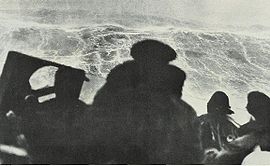
Derry
Derry or Londonderry is the second-biggest city in Northern Ireland and the fourth-biggest city on the island of Ireland. The name Derry is an anglicisation of the Irish name Doire or Doire Cholmcille meaning "oak-wood of Colmcille"...
- after the sinking of U-1200, Pevensey Castles steering broke in a northerly gale off the mouth of the River Foyle
River Foyle
The River Foyle is a river in west Ulster in the northwest of Ireland, which flows from the confluence of the rivers Finn and Mourne at the towns of Lifford in County Donegal, Republic of Ireland, and Strabane in County Tyrone, Northern Ireland. From here it flows to the City of Derry, where it...
. Rayner nearly lost his ship on the long sandy spit leading to Magilligan Point before hand steering was connected. He writes that at this point "The candle was burned out" (Escort, p. 230). He sought three weeks leave of Max Horton who then posted him, in the months before V-E Day, to a senior staff role with Channel Command, Portsmouth, in the tunnel complex of Fort Southwick http://www.portsdown-tunnels.org.uk/index.html behind Portsmouth Harbour ('Escort' pp. 232–241). Here, overseeing radar guided plots from deep underground in a way that would have been impossible at the start of the campaign, Rayner applied his specialist experience to the deployment of a large force of anti-submarine warships in the closing months of the war. Rayner speaks in 'Escort' ('Escort' pp. 235–236) of his respect for one of his colleagues at the fort - First Officer Audrey Faith Parker, OBE, WRNS
Women's Royal Naval Service
The Women's Royal Naval Service was the women's branch of the Royal Navy.Members included cooks, clerks, wireless telegraphists, radar plotters, weapons analysts, range assessors, electricians and air mechanics...
- for the seafaring experience she brought to her operational work. It was to her and her husband Gordon that Rayner, in 1946, after a stint as temporary commander of a Naval Air station at Kirkistown near Cloughy on the east coast of Northern Ireland, sold his yacht, laid up in north Wales for the duration, and moved his household to the first of several farms in the English home counties
Home Counties
The home counties is a term which refers to the counties of South East England and the East of England which border London, but do not include the capital city itself...
.
During a campaign that had lasted from 1939 to 1945, Rayner's youngest son, Vyvyan, reckoned (in April 2006) that his father took "as little as four or five weeks home leave in the whole period." After 24 years with the 'wavy navy' Rayner retired from the RNVR in 1949.
Decorations
Rayner's DSC was announced in the London GazetteLondon Gazette
The London Gazette is one of the official journals of record of the British government, and the most important among such official journals in the United Kingdom, in which certain statutory notices are required to be published...
of 29 December 1940, dated 1 January 1940, for the "hard and perilous task of sweeping the seas clear of enemy mines, and combating submarines" while commanding the trawler Loch Tulla. On 26 September 1941 it was announced that he had been Mentioned in Despatches 'for good services in action against enemy submarines' while commanding HMS Verbena. On 23 March 1943 the Gazette announced the award of the Volunteer Reserve Decoration
Volunteer Reserve Decoration
The Volunteer Reserve Decoration was awarded to commissioned officers in the United Kingdom's Royal Naval Volunteer Reserve for long service and good conduct.The VRD was established in 1908...
(VRD). On 25 May 1945 he was awarded a bar to his DSC "for courage, skill and perseverance ... in successful operations against enemy submarines."
Rayner was credited with the sinking of one U-Boat on 11 November 1944 - U-1200, commanded by Hinrich Mangels, "to pay me back for Warwick" ('Escort' p. 221)http://uboat.net/boats/u1200.htm. In an escort group action the fatal depth charges were dropped by HMS Launceston Castle
HMS Launceston Castle (K397)
HMS Launceston Castle was a Castle-class corvette of the United Kingdom's Royal Navy, named after Launceston Castle in Cornwall.She was launched by Blyth Shipbuilding and Drydock Company at Blyth in Northumberland on 27 November 1943....
under Lieutenant R M Roberts, DSC, RNVR.
Rayner, though at the time given credit for sinking or damaging an unidentified U-Boat on 22 May 1941' http://www.unithistories.com/officers/RNVR_officersR.html, had doubts even then, as he had about an earlier incident ('Escort' pp. 40–41) while in charge of 14th Anti-Submarine Group on HMT Loch Tulla, sailing towards Scapa Flow. He writes of picking up a strong asdic signal north of the Humber on the UK east coast, a depth charging exercise and a pool of oil, and later (p. 51) he mentions “thinking” that his first DSC, announced on 1 January 1940, was “probably” for this action “off Flamborough Head”. He was uncertain whether this involved a genuine sinking, writing of the greater “difficulty” of damaging the “pressure hull” of a “modern submarine”. Later (pp. 92–94) Rayner refers to an action on 22–23 May 1941 when, in HMS Verbena, he engaged a U-boat on the surface after it had torpedoed the Dutch tanker Elusa and surfaced to inspect the burning wreck. The U-boat dived. Rayner depth charged a strong asdic contact, saw oil on the surface, lost contact and guided HMS Churchill, with deeper depth charges, to the same target, both ships remaining in the area until dawn on 24 May 1941. In the back inside cover of 'Escort' Rayner's map of Western Approaches shows the cross-swords symbol of an engagement and the words "U-boat damaged by Verbena 22.4.41". Many years later - 2006 - Gudmundur Helgason, researcher of the Battle of the Atlantic http://uboat.net points out that Elusa was sunk by U-93 http://uboat.net/boats/u93.htm "which certainly survived the attack" adding that "there were lots of those attacks reported (often with seemingly very convincing evidence at the time) that failed to sink or even damage an U-boat. Since 1955 there have been loads of revisions of U-boat fates, almost to this day even."
Writer
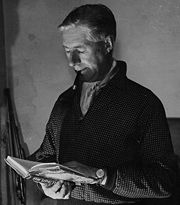
Nicholas Monsarrat
Commander Nicholas John Turney Monsarrat RNVR was a British novelist known today for his sea stories, particularly The Cruel Sea and Three Corvettes , but perhaps best known internationally for his novels, The Tribe That Lost Its Head and its sequel, Richer Than All His Tribe.- Early life :Born...
's enormously successful post-war novel The Cruel Sea published at almost the same time as Rayner's book. In his editor's foreword to 'Escort', Stephen Roskill writes of Rayner's authority to speak on his subject: "I know of no other officer, let alone one of the Royal Naval Volunteer Reserve, who served continuously for more than five years in command of escort vessels; nor of any other who graduated from a trawler at the very beginning to a corvette, then to a small destroyer, and finally to command of a group of the new and greatly improved war-built escort vessels."
Mike Raymond of the Flower Class Corvette's Association http://www.fcca.demon.co.uk/ reports a portrait of Rayner 'with pipe and beard' in the frontispiece of 'Escort' - the picture at the start of this article emphasising this is more biography than history. Yet a 10 year perspective, enabled Rayner in 1955, to weave his and his men's experiences into a larger account of the Battle of the Atlantic, recording, for example, a fleeting and enticing glimpse of the chief protagonist in a four-day sea battle that began with the sinking of Britain's finest warship and closed with the destruction of a German battleship that ended Hitler's use of large surface raiders against allied convoys. While escorting the homeward-bound convoy SC 31, on board Verbena in company with Commander Bostock of HMS Churchill, Rayner spotted a big ship on the horizon hurrying southward: "... she was hull down and difficult to identify. I made to Churchill, 'Are you reporting what I think I see?' and got back the reply, 'Better not - identification by no means certain. Might cause confusion. Gather Suffolk has the situation in hand.'" Suffolk and Norfolk were cruisers following the German battleship Bismarck
German battleship Bismarck
Bismarck was the first of two s built for the German Kriegsmarine during World War II. Named after Chancellor Otto von Bismarck, the primary force behind the German unification in 1871, the ship was laid down at the Blohm & Voss shipyard in Hamburg in July 1936 and launched nearly three years later...
which, on 24 May 1941 had sunk HMS Hood
HMS Hood (51)
HMS Hood was the last battlecruiser built for the Royal Navy. One of four s ordered in mid-1916, her design—although drastically revised after the Battle of Jutland and improved while she was under construction—still had serious limitations. For this reason she was the only ship of her class to be...
on which Rayner had served as a midshipman for three months in 1932.
A year after 'Escort' came Rayner's first novel, the story of a prolonged duel between a U-boat and a British destroyer - The Enemy Below
The Enemy Below
The Enemy Below is a 1957 war film which tells the story of the battle between the captain of an American destroyer escort and the commander of a German U-boat during World War II. It stars Robert Mitchum, Curt Jürgens, David Hedison and Theodore Bikel. The movie was directed and produced by Dick...
- adapted in 1957 for a film by Dick Powell
Dick Powell
Richard Ewing "Dick" Powell was an American singer, actor, producer, director and studio boss.Despite the same last name he was not related to William Powell, Eleanor Powell or Jane Powell.-Biography:...
, in which the writer's destroyer Hecate became the USS Haynes - in actuality USS Whitehurst - while his British captain, John Murrell, became an American played by Robert Mitchum with Curt Jürgens playing Rayner's U-boat skipper, Kapitän von Stolberg. Powell displays Rayner's book at the start of the trailer of 'The Enemy Below'. Some of the actual experiences described in the novel and later transferred to film can be read in Rayner's low-key account of his encounter between corvettes and U-1200 off southern Ireland on 11 November 1944 between pages 224-228 of 'Escort'. In his novel 'The Long Fight'(1958) Rayner wrote about a three day ship-to-ship engagement in the Indian Ocean during the Napoleonic Wars
Napoleonic Wars
The Napoleonic Wars were a series of wars declared against Napoleon's French Empire by opposing coalitions that ran from 1803 to 1815. As a continuation of the wars sparked by the French Revolution of 1789, they revolutionised European armies and played out on an unprecedented scale, mainly due to...
; about tank warfare in 'The Small Spark of Courage'(1959) (titled "Valor" in US editions of the novel), and about convoy escort duty in 'The Crippled Tanker'(1962) (titled "The Long Haul" in US). In 1966, with Alan Wykes, he wrote 'The Great Yacht Race', an illustrated account of a millionaires' yacht race from New York to Cowes in December 1866. Between 1961-1963 Rayner also published books on sailing, safety at sea in small craft and starting motorboating.
Designer of Small Boats
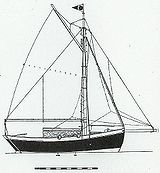
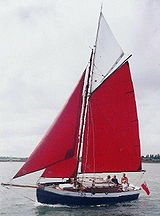
Loch Fyne
Loch Fyne is a sea loch on the west coast of Argyll and Bute, Scotland. It extends inland from the Sound of Bute, making it the longest of the sea lochs...
, he records passing "a ship which from the lines of her hull I think to have been the original Blue Dragon... if it were, it is poetic justice that I should meet her on my first cruise in my own designed ship in Scottish waters for it was her exploits as detailed in 'The Log of the Blue Dragon, by C.C.Lynam, read in "the library of a midland county preparatory school" that "first started the sailing canker" though "vows then made to sail my own ship to Scotland had to wait twenty years for fruition." (p. 369 Rayner 1938). Starting with an 18' open boat, and progressing via a 16' half-decked day sailer to a small converted fishing yawl, followed by a converted ex-fishing boat and then the 14 ton Tredwen barge yacht Pearl - burnt out on her moorings - Rayner was at last, in 1936, able try his hand at designing his own boat "after studying the 'How To' articles in the Y.M." (Yachting Monthly Feb 1937, p. 334). Robinetta, a 4½ ton auxiliary gaff cutter, was built for him at the Rock Ferry
Rock Ferry
Rock Ferry is an area of Birkenhead on the Wirral Peninsula, England. Administratively it is a ward of the Metropolitan Borough of Wirral. Before local government reorganisation on 1 April 1974, it was part of the county of Cheshire...
yard of the Enterprise Small Craft Company, Birkenhead
Birkenhead
Birkenhead is a town within the Metropolitan Borough of Wirral in Merseyside, England. It is on the Wirral Peninsula, along the west bank of the River Mersey, opposite the city of Liverpool...
, and launched on 10 May 1937.
Elected in March 1935 to the Royal Cruising Club http://www.rcc.org.uk/- 'an association of yachtsmen who prefer navigation to racing and are full of passionate interests' (Arthur Ransome 1912) - Rayner set out, in summer 1937, to follow 'skipper' Lynam's wake to the Western Highlands. Lynam's Blue Dragon was a small clinker built yawl of his own design, as was Robinetta http://robinetta-log.blogspot.com/p/robinetta.html, built on the Mersey
Mersey
Mersey may refer to:* River Mersey, in northwest England* Mersea Island, off the coast of Essex in England * Mersey River in the Australian state* Electoral division of Mersey in the state of Tasmania, Australian...
, from where he sailed her to the Firth of Clyde
Firth of Clyde
The Firth of Clyde forms a large area of coastal water, sheltered from the Atlantic Ocean by the Kintyre peninsula which encloses the outer firth in Argyll and Ayrshire, Scotland. The Kilbrannan Sound is a large arm of the Firth of Clyde, separating the Kintyre Peninsula from the Isle of Arran.At...
. Thus Rayner, before he was 30, (and according to a self-description in his file at the Royal Institution of Naval Architects
Royal Institution of Naval Architects
The Royal Institution of Naval Architects is an international organisation representing naval architects. It is an international professional institution whose members are involved world-wide at all levels in the design, construction, repair and operation of ships, boats and marine...
(RINA)) became an amateur yacht designer and experienced small boat sailor. Between 1937 and 1938 Rayner completed two short cruises in Robinetta, sometimes with his wife - "E" - and sometimes with RNVR comrades, Dick Taudevin and W.H.Simcoe, writing meticulous logs of intricate exploration of sea lochs with the added excitement of swift and sometimes rough open water passages, including encounters with overfalls and squalls, entranced by the scenery of these complicated shores. These pleasures ceased abruptly with the start of the war. Robinetta was laid up on chocks for the duration at a yard in Beaumaris, N.Wales, and sold in 1946.
After the long war at sea Rayner moved with his family to a farm at Hook near Basingstoke in Hampshire, and then to another farm near Burghclere, south of Newbury in Berkshire, and gave his attention to farming, horse riding and writing. In 2006 the owner of their old home, Earlstone Manor Farm, recalls accounts of Denys and Elizabeth Rayner's children's "extraordinary and happy childhood here, and the huge generosity of the Rayners, who took in old shell-shocked warriors, German Jewish refugee children, and the unhappy son of a British fascist leader, who were all cared for, loved and given security, at a time when conditions were still very primitive here and the family themselves extremely deprived."
At Earlstone the Rayners were neighbours to the Roskills, and it was Captain S.W.Roskill who encouraged his neighbour to write down his recollections of the war. Rayner's eldest son recalls that, as a result, his father "started thinking about boats, the sea, and boat design all over again". Publishing 'Escort', and then 'The Enemy Below', Rayner "gradually morphed back to where he had always wanted to be - in yacht design". He built his younger son a dingy to row on a local lake. "When it was finished", says Paul Vyvyan, "I was too big for it." So his dad acquired a small yacht - a Mystic, sail number 2, designed by Robert Tucker from C. E. Clark Boat Builders at Cornubia Yacht Yard at Cowes
Cowes
Cowes is an English seaport town and civil parish on the Isle of Wight. Cowes is located on the west bank of the estuary of the River Medina facing the smaller town of East Cowes on the east Bank...
called Orchid - ostensibly for the boy, but he called it "our ship", making her easier to sail by adding a new stern.
In the late 1950s, a local manufacturer of plywood caravans asked Rayner to design a plywood dinghy to be offered with each caravan. As result of this collaboration Rayner started the Beacon Boat Company at a redundant turnery workshop in Donnington, a village on the River Lambourn
River Lambourn
The River Lambourn is a chalk stream in the English county of Berkshire. It rises in the Berkshire Downs near its namesake village of Lambourn and is a tributary of the River Kennet, which is itself a tributary of the River Thames.-Perennial River:...
north of Newbury, and applied all his enthusiasm and practicality to building and selling small family sailing boats of distinctive design.
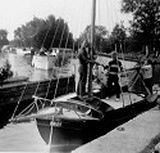
Resorcinol glue
Resorcinol glue is a glue that is high in both wet and dry strength and resistant to high temperatures. It is used for gluing lumber or assembly joints that must withstand severe service conditions. Resorcinol withstands outdoor exposure, tropical or sub zero temperatures, as well as salt or...
, Rayner marked his return to the sea by building a 20 foot hard chine bilge keel gunter rigged sloop - the Westcoaster - designed initially for a customer wishing to navigate the difficult waters and scarce harbours of the Bristol Channel
Bristol Channel
The Bristol Channel is a major inlet in the island of Great Britain, separating South Wales from Devon and Somerset in South West England. It extends from the lower estuary of the River Severn to the North Atlantic Ocean...
, where Rayner had been torpedoed in 1944. Rayner gave the Westcoaster "sitting head room for tall men" - rare in yachts so small - while ingeniously camouflaging the reverse sheer needed for such generous accommodation by carrying the decks out to the sides of the boat as he had with Robinetta 20 years earlier. Similarly all the Westcoaster's running rigging came back to the cockpit making her easy to handle single-handed. He sailed and demonstrated the first of such yachts, painted a rich royal international blue - often called Oxford Blue - enthusing about its good looks, its affordability, its practicality for weekend "pottering" and fitness for deeper waters despite a draft of no more than 2'3" (70 cm). This design ensemble was topped by Rayner's preference for the gunter
Gunter
In sailing, a gunter is used for two main configurations of rig:#The gunter is defined as a wire that leads from one point near the end of a gaff to a point near the other end. A block travels along this wire, and a halyard is attached to this block...
rig, its short mast, compared to a Bermudian, making it easier to tow on a trailer, to lower and raise, for the bridges of inland waterways, as well as allowing a swift reef - by lowering the boom - in a squall. Rayner also wrote that he valued the greater 'lifting' quality of a gaff or gunter mainsail as compared to the Bermudian main, prior to the wider use, with that rig, of masthead Genoa's - headsails of greater area than the mainsail - which in Rayner's view, in 1962, was 'the herald of rigs to come' with 'great aerodynamic efficiency and with enormous lift!', and returning, in effect, "to the lateen-shaped loose-footed sails of the Mediterranean but with a taut forestay replacing the heavy lateen yard..." ('Small Boat Sailing' p. 43) A small number of Westcoasters were later modified by the addition of a small bowsprit
Bowsprit
The bowsprit of a sailing vessel is a pole extending forward from the vessel's prow. It provides an anchor point for the forestay, allowing the fore-mast to be stepped farther forward on the hull.-Origin:...
, with the cutter rig giving an even greater sail area.
Bilge or twin keels, a concept for many more years unfamiliar in America, allowed a boat to take the ground upright on a tripod comprising keels and a sturdy skeg, manoeuvre in shallow water, load and tow easily behind a family saloon, and be conveniently launched. Thus Rayner, developing a concept pioneered in 1922 by a fellow member of the RCC, Arthur Balfour, later Lord Riverdalehttp://www.rina.org.uk/showpubl.pl?id=5900&n=565, and became a key player in the expanding field of affordable chine plywood yachts, brilliantly popularised by Robert Tucker's http://www.tucker-designs.com/about.html Mystic, Debutante and Silhouette. Such a vessel could navigate canals and shallow estuaries including short-cuts through swatchways, take the ground safely and 'look after her crew' in hard weather, close to and off shore. It was a specification aimed at the innovative concept of 'family sailing', creating, and responding to, the enthusiasm, pockets and holidays of a post-war generation unused to enjoying the sea as a place for recreation and adventure.
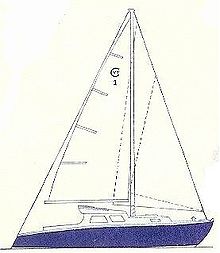

Jack Hargreaves
Jack Hargreaves OBE was an author and television presenter in the UK. His enduring interest was to comment without nostalgia or sentimentality on accelerating distortions in relations between the city and the countryside....
- hydrofoil sectioned twin keels, flat on the outside and curved on the inside and very slightly toed in. As well as serving the same function as fin keels, the leeward moulded bilge keel used the Bernoulli's principle
Bernoulli's principle
In fluid dynamics, Bernoulli's principle states that for an inviscid flow, an increase in the speed of the fluid occurs simultaneously with a decrease in pressure or a decrease in the fluid's potential energy...
, to resist leeward drift as the boat heeled on a beat. Hargreaves' stepson with a companion, Chris Jameson, as her skipper, proved Danica by taking her through France by river and canal and on through the Mediterranean to Athens
Athens
Athens , is the capital and largest city of Greece. Athens dominates the Attica region and is one of the world's oldest cities, as its recorded history spans around 3,400 years. Classical Athens was a powerful city-state...
, returning via the Bay of Biscay
Bay of Biscay
The Bay of Biscay is a gulf of the northeast Atlantic Ocean located south of the Celtic Sea. It lies along the western coast of France from Brest south to the Spanish border, and the northern coast of Spain west to Cape Ortegal, and is named in English after the province of Biscay, in the Spanish...
where she successfully weathered F10 gale force winds (September 1962), but her construction costs focused Rayner's attention on the emerging technology of glass-reinforced plastic
Glass-reinforced plastic
Fiberglass , is a fiber reinforced polymer made of a plastic matrix reinforced by fine fibers of glass. It is also known as GFK ....
(GRP).
Having founded Beacon Boats Co. Ltd. to make and sell Westcoasters - about 60 altogether - and then the Corvette, Rayner experimented with a new enterprise making GRP sailing dinghys. From this temporary project he embarked on the factory manufacture of an ideal family sailing boat expanding, in 1963, to larger premises - temperature-and-humidity-controlled - as the firm of Westerly Marine Construction Ltd., at Hambleden Road, Waterlooville near Portsmouth on the Solent
Solent
The Solent is a strait separating the Isle of Wight from the mainland of England.The Solent is a major shipping route for passengers, freight and military vessels. It is an important recreational area for water sports, particularly yachting, hosting the Cowes Week sailing event annually...
, with himself as Chief Designer, having become, in 1964, an Associate of the RINA. He recruited as his directors Kenneth Bates, Micheal C.B.Hurd and David G.M.Sanders and Kenneth Todd, while Dodie Walker in Sales was regarded as integral to an enterprise Rayner was determined should attract customers who cared as much about his boats' interior comfort and convenience as their sailing qualities, for which Rayner sought Lloyd's certification. Two skilled boatbuilders - affectionately esteemed by Rayner as 'the walrus' and 'the carpenter' - were recruited to do the vital job of building the pattern moulds basic to GRP production. GRP was still so recent that he had to be satisfied with a Lloyd's Series Production Certificate affirming that the 4½ ton Westerly 22 – the company's first design – had been built under Lloyd's supervision including inspections and tests of hull strength and the factory conditions under which the moulded fibre glass used in construction went through the process, key to its long term integrity, of curing. Knowing that GRP yachts had not been around long enough to arrive at a proper assessment by Lloyd's of their durability, Rayner added exacting standards of his own to his designs, explaining why, after 40 years, such boats are still trusted by their owners.http://www.westerly-owners.co.uk/
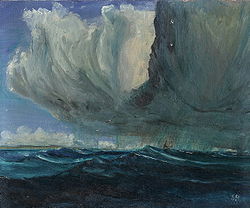
Barbados
Barbados is an island country in the Lesser Antilles. It is in length and as much as in width, amounting to . It is situated in the western area of the North Atlantic and 100 kilometres east of the Windward Islands and the Caribbean Sea; therein, it is about east of the islands of Saint...
, read "Welcome to the Caribbean and well done! I think this is a justified remark because if you do not get this letter you won't have done so well! I am so glad you have Susanna with you. I shall of course calm down anyone who gets jumpy because I have complete confidence in you and the boat." Young Tiger, crewed by Simon Baddeley and Sue Pulford, telegramed news of her arrival at Bridgetown
Bridgetown
The city of Bridgetown , metropolitan pop 96,578 , is the capital and largest city of the nation of Barbados. Formerly, the Town of Saint Michael, the Greater Bridgetown area is located within the parish of Saint Michael...
on 5 January to Rayner at the 1966 London Boat Show
London Boat Show
The London Boat Show is held each January at the ExCeL Exhibition Centre in London, just opposite the O2 and the centre of London's business and entertainment centre. It is a very large event, now in its 54th year, which uses ExCeL's two 32,500 square metre halls...
with the words "EASY 29 DAYS. SIMON". They had sailed 2900 miles from the Las Palmas de Gran Canaria
Las Palmas de Gran Canaria
Las Palmas de Gran Canaria commonly known as Las Palmas is the political capital, jointly with Santa Cruz, the most populous city in the Autonomous Community of the Canary Islands and the ninth largest city in Spain, with a population of 383,308 in 2010. Nearly half of the people of the island...
to Barbados
Barbados
Barbados is an island country in the Lesser Antilles. It is in length and as much as in width, amounting to . It is situated in the western area of the North Atlantic and 100 kilometres east of the Windward Islands and the Caribbean Sea; therein, it is about east of the islands of Saint...
in 29 days. Peter Guinness, Rear-Commodore of the Royal Cruising Club, in awarding the RCC Challenge Cup, wrote of a winning cruise that ended in Miami USA on 17 April 1966 "in a small, or even very small, ship". (RCC Journal p.xi. 1967)
Achievement
Having led men and commanded ships in the Battle of the Atlantic, undoubtedly the most protracted and one of the most crucial of Britain's World War II campaigns, since it was about control of our island supply lines, Denys Rayner, who described himself, in his biographical account of the war in the Atlantic, as an 'amateur sailor', gave himself as much to the peace that followed, as he had to the war that won it.
Rayner's guidebooks for such adventurers include 'Safety in Small Craft', Coles, Harrap, De Graff (1961) and 'Small Boat Sailing', Collins Nutshell Books (1962). Seacraft technologies, especially navigational aids, have been transformed since these books were written, yet they contain timeless wisdom about taking a small ship to sea and bringing her home - without fuss. In 'Safety in Small Craft' Rayner writes: “In any reasonable weather it is the diminutive size of the yacht which makes long passages under sail such thrilling affairs, and one of the reasons why I, for one, find the smallest possible craft the most rewarding” as well, he added, as costing less.
Ben Rayner's greatest peace time contribution lay in his approach to designing, building and selling such small craft. A fascination with making model destroyers at school evolved into the making of Robinetta in which for a few years he voyaged for pleasure - a pleasure which, after his long war service, he made available to thousands. Starting with Robinetta - based in 2006 on the River Orwell
River Orwell
The River Orwell flows through the county of Suffolk in England. Its source river, above the tidal limit at Stoke Bridge, is known as the River Gipping. It broadens into an estuary at Ipswich where the Ipswich dock has operated since the 7th century and then flows into the North Sea at Felixstowe...
near Harwich and still sailing, and then the rebuilt Orchid to share with his youngest son, Rayner graduated via the one-off Corvette to the Westerly 22, to the Westerly 25, the Westerly 30, the Windrush (a re-worked W25), and the Nomad (a re-worked W22). Applying the husbandry, and inventiveness, that characterised his years as a professional sailor, Rayner applied design and techniques, including the crucial process of curing now recognised as so vital to enduring fibre glass construction (du Plessis, H., 2006 4th ed.), to products that sold themselves. In the recent words of one of his sons, "He was delighted when the butcher, the baker and candlestick maker arrived at the London Boat Show
London Boat Show
The London Boat Show is held each January at the ExCeL Exhibition Centre in London, just opposite the O2 and the centre of London's business and entertainment centre. It is a very large event, now in its 54th year, which uses ExCeL's two 32,500 square metre halls...
in the early 60s and put down deposits in cash. Boats at that time were produced by 12 men at 6 vessels per annum. With 12 men we built 50 a year. Their yachts cost £6,000. Ours were on a trailer for £1800." But if these small craft were swiftly made and so affordable, none left Rayner's factory unfit for the sea, of which he wrote "neither cruel nor kind ... Any apparent virtues it may have, and all its vices, are seen only in relation to the spirit of man who pits himself, in ships of his own building, against its insensate power." (Preface to 'Escort')
Rayner's home was in West Kirby until 1944, after which the family moved south to Holt Farm, Hook, near Basingstoke, Hampshire, from where he moved to Earlstone Manor Farm, Burghclere, moving again in mid-1963 to Hermitage Farm, Hermitage, both near Newbury in Berkshire. His last home, where he moved in late 1964, was Quarry Farm, West Meon, Hants. He married Isabelle Elizabeth (née Board) in 1933. They had a daughter, Clare, born 1938, and two sons, Martin Drake born in 1934 and Paul Vyvyan born in 1948, who scattered his father's ashes off Gilkicker Point.

